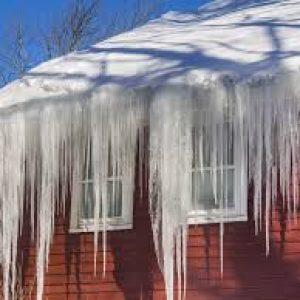 Ever see ice dams forming over your roof of your home every winter? What can u do to prevent them in the future winter season and how can they be removed during the cold weather?
Ever see ice dams forming over your roof of your home every winter? What can u do to prevent them in the future winter season and how can they be removed during the cold weather?
What is an ice dam? An ice dam is a solid band of ice that forms along the edge of a roof of a home, preventing water and melting snow from draining properly. It occurs during the winter season. Since water cannot drain well, it backs up and often can be forced beneath the shingles, which then leaks into your home. Water entering this way can have multiple exit points, causing damage to insulation, walls, and ceilings.
If you have never had an ice dam, you should still be prepared given they can form at any time under the right conditions during the cold weather season. Prevention is important, and knowing what to look for is key.
How Ice Dams Form: The earlier you can detect signs of ice dam formation, the better you can prevent any damages. Several causes may be: mild daytime winter weather, flat-pitched roofs, deep snow piles and poor insulation and ventilation.
Preventing Ice Dams: Don’t wait until water leaks into your home. A little bit of preventative maintenance can go a long way in keeping ice dams from ever forming on your roof.
Install Heat Cables: Electric heat cables can be installed along the edge of a roof to melt snow before an ice dam forms. This is a good fall season project, before it gets too cold. Do-it-yourself heat cable kits are available from most home improvement stores. How much they cost depends on the size of your roof and the length of cable you need, but generally, a heat cable kit can cost anywhere from $20 to $200.
The most important thing with ice heating cables is that they should have their own power source and be connected to a thermostatically controlled power device. According to the Consumer Product Safety Commission, about 3,300 residential fires occur each year because of heat cables. These fires cause 150 injuries, 20 deaths, and over $20 million in property damage.
Improve Attic Insulation and Ventilation: One of the very best ways to permanently address the problem of recurring ice dams is to improve the insulation of your attic. Focus on plugging gaps, realigning improperly installed insulation, and stopping the trickle of warm air from areas like conduits, electrical outlets and light fixtures. This can make a huge difference, however calling a professional may be necessary for this kind of job. And just a reminder, this does not mean piling on more insulation on top of old insulation either; no matter how much insulation you use, it will not stop the ice dams from forming. To further cool your attic, you can improve ventilation by installing ventilation systems. There are many options out there, but installation may require a professional for service.
Use a Roof Rake: The best way to prevent an ice dam is to remove the snow from your roof before it has a chance to melt and refreeze. These types of rakes allow you to pull snow off your roof while standing firmly on the ground. Roof rakes work best when removing fresh, fluffy snow rather than wet or hard snow that has solidified.
Ice Dam Removal: If you find yourself with an ice dam, removal should be an immediate priority. There are several ways to go about this process, but here are a few examples: You can slowly chip and hammer away at each section slowly, it is often very effective. You can also get a spray bottle, filled with warm water, and lightly mist or spray sections at a time. Home improvement stores also sell chemical de-icers too, and they often prove to clear a roof ice dam quickly and effectively. Watch for ingredients, as some have been known to cause damage or harm to your roof or shrubbery or plants.
Lastly, if need be, hire a professional to come remove the largest ice dams from your roof of your home, safely and securely.
